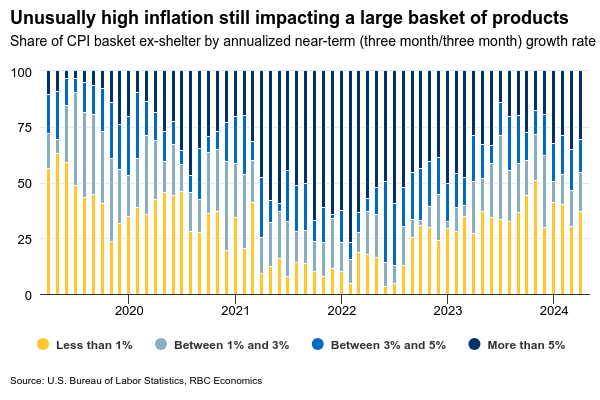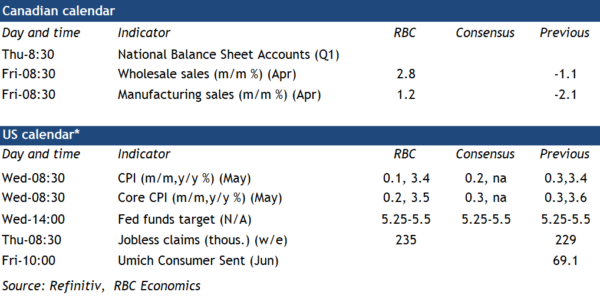Wednesday’s U.S. Consumer Price Index data and the Federal Reserve’s interest rate decision will be in focus after the Bank of Canada and European Central Bank cut rates the week before.
The Fed is not expected to follow suit—at least not right now. We expect U.S. CPI growth numbers out in the morning before the rate decision to look a little better. But that follows a string of upside surprises and persistent economic outperformance that have made near-term U.S. interest rate cuts much less likely compared to other advanced economies.
We look for headline CPI growth in May to hold at 3.4% year-over-year with the underlying details looking slightly better. Energy prices likely declined in May as oil prices edged lower. But “core” (excluding food and energy) price growth is also expected to edge down to 3.5% (from 3.6% in April) on a more normal-looking 0.2% month-over-month increase. Home rent price growth should also slow alongside a lower month-over-month increase in the core services ex-rent measure that Fed policymakers have been watching closely. The April increase in that measure already edged down to 0.4% following three straight upside surprises (averaging 0.7% per month) over the first three months of the year.
The diffusion index, which measures the breadth of inflation pressures, has shown little improvement over the past few months. Fed policymakers still think the current level of interest rates is “restrictive” enough to bring inflation back to the 2% target. But another round of firm U.S. employment numbers in May, including a tick up in wage growth, reinforced that there is no pressure on the Fed to lower interest rates quickly. Our base case assumption is that the Fed won’t be in a position to cut interest rates until December, and that shift is still contingent on seeing economic growth and inflation slow.

Week ahead data watch
Manufacturing sales likely increased by 1.2% on higher sales of transportation equipment, according to Statistics Canada’s advance estimates. The Industrial Product Price Index for the manufacturing sector rose by a similar amount by our count (on a seasonally adjusted basis), suggesting that most of the increase in sales came from higher prices rather than higher sale volumes.
Statistics Canada’s early estimate of core wholesale sales was up 2.8% in April, largely driven by sales growth in the motor vehicle and parts sector.
Canadian household net worth likely rose in Q1 with stronger equity markets boosting financial asset values. The household debt to income ratio likely edged lower from 178.7 in Q4 with mortgage and non-mortgage debt levels little changed but incomes still rising. Earlier interest rate increases are continuing to boost debt payments with a lag, but household disposable incomes also rose sharply in Q1 to likely leave the ratio of debt payments to incomes little changed (although still close to record high levels) in Q1.
A strike by Canadian border workers could start as soon as end of day on Friday, June 7. Most border workers are “essential” and not able to legally walk off the job, but a work-to-rule campaign could slow border crossings. A prolonged strike could significantly disrupt supply chains and would restrict cross-border travel. A similar strike in 2021 happened when the Canada/U.S. border was still closed to non-essential travel during the pandemic and was too short (three days) to have a significant impact on economic data.










